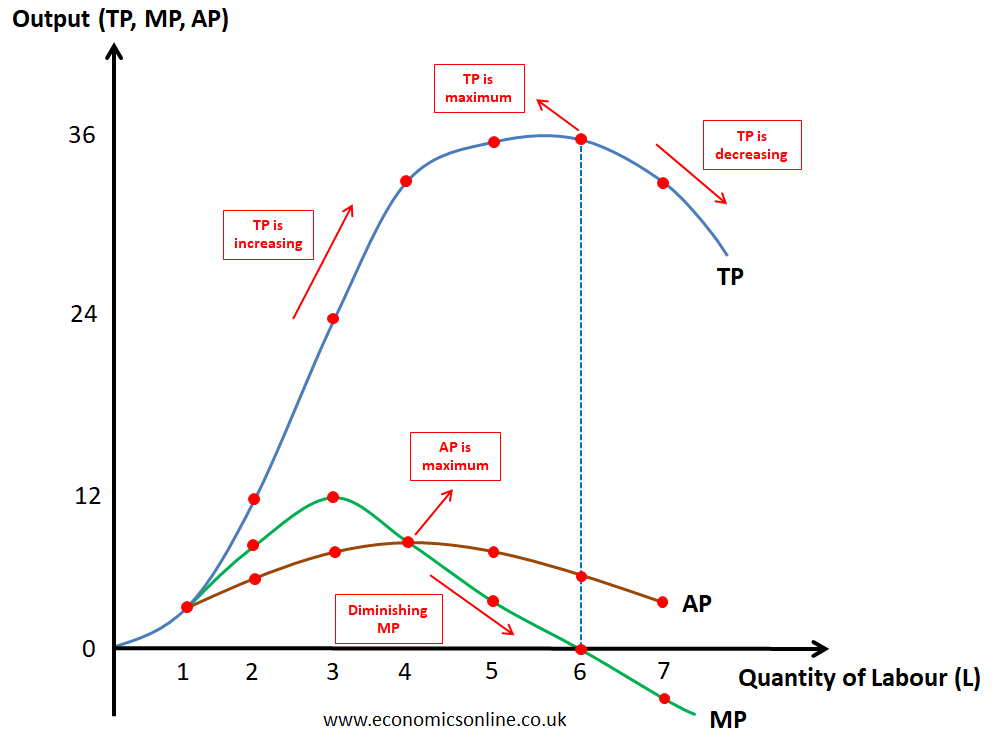
Law of Diminishing Returns
What is the Law of Diminishing Returns?
This law states that when a variable factor of production is added to some fixed factors of production, the marginal product (MP) initially increases but eventually diminishes.
This law explains the short-run production function and is also called the law of diminishing marginal returns, the law of variable proportions, or the law of diminishing marginal productivity.
Another definition of this is that when a variable factor of production is added to some fixed factors of production, the total product (TP) increases at an eventually diminishing rate.
History of the Law of Diminishing Marginal Returns
The law of diminishing returns has a history that can be traced back to economists like Jacques Turgot, Thomas Robert Malthus, and David Ricardo. Turgot mentioned diminishing returns in the mid-1700s, while Malthus associated it with population growth and limited food production. Ricardo developed the concept further, focusing on the diminishing output increases when adding more labor and capital to fixed land. Neoclassical economists or classical economists viewed diminishing returns as disruptions in the production process when adding more labour to a fixed amount of capital. Overall, these economists' contributions have shaped our understanding of diminishing returns in resource allocation and productivity.
Some Basic Terms
To understand the law of monopolistic competition in a better way, let's first look at some basic terms.
Production
The process of converting inputs into outputs is called production. The inputs are the resources or factors of production (land, labour, capital, and enterprise). The output can be goods or services.

Short Run (SR) Time Period
A time period in which some factors of production are fixed and some factors of production are variable is called a short run time period. The short-run time period is sufficient to change some factors of production but not all. In the short run, at least one factor of production must be fixed, and at least one factor of production must be variable.
Returns
Goods and services produced through the production process are called returns. They are also called outputs, products, or physical products.
Types of Returns
There are three types of returns, or products.
Total Product (TP)
The total output produced through the production process in a given time period is called the total product (TP).
Marginal Product (MP)
Extra output produced by using an extra unit of a variable factor of production is called marginal product (MP).
Average Product (AP)
The total product divided by the number of units of a variable factor of production is called the average product (AP).
Production Function
The relationship between inputs and outputs is called the production function.
Short Run Production Function
The relationship between output and the variable inputs in the short run is called the short-run production function. According to the short run production function, output or return is the function of variable inputs.
The law of diminishing marginal returns is used to explain the short run production function.
Understanding the Law of Diminishing Returns
Assumptions
The law of diminishing marginal returns has the following assumptions:
- The time period is short run.
- Labour is a variable factor of production.
- Land and capital are constant production factors.
- All units of variable factor production (all workers) are equally skilled and motivated.
Data Example
Let’s consider the following data table in order to understand the law of diminishing marginal returns.
In the above data table, labour is a variable factor of production, and its quantity is increased from 0 to 7.
The marginal product is also given, and it increases up to the third unit of labour. After the third unit of labour, the marginal product starts diminishing. This is according to the law of diminishing marginal returns, that with an increase in labour, the marginal product initially increases but eventually diminishes.
Total product (TP) is calculated by adding marginal products. The average product (AP) is calculated by dividing the total product (TP) by the units of labour (L).
Graph of the Law of Diminishing Returns
Now let’s consider the following graph of the law of diminishing marginal returns, which is made by using the above data table.

In the above diagram, the quantity of labour (L) is taken on the horizontal axis (X-axis) as the units of input, and the output (TP, MP, AP) is taken on the vertical axis (Y-axis). The graph of total product (TP) is in blue colour. The graph of marginal product (MP) is in green colour and the graph of average product (AP) is in brown colour.
Increasing Returns
The graph of marginal product (MP) is initially upward sloping up to the third unit of labour, which shows increasing marginal product with an increase in the units of labour. This is called increasing returns.
Reasons of Increasing Returns
Initially, when a variable factor of production (labour) is added to the fixed factors of production (land and capital), the marginal product (MP) starts increasing because of the division of labour and better utilisation of the fixed factors of production.
Diminishing Returns
The graph of marginal product (MP) eventually becomes downward sloping after the third unit of labour, which shows decreasing marginal product with an increase in the units of labour. This is called diminishing returns.
Reasons of Diminishing Returns
Eventually, when more of a variable factor of production (labour) or more employees are added to the fixed factors of production (land and capital), the marginal product (MP) starts decreasing. This decrease is because of applying too much variable input as compared to fixed inputs and because of less utilisation of fixed factors of production by each worker.
Relationships
Relationship between Marginal Product (MP) and Total Product (TP)
- When the marginal product is positive, the total product increases.
- When the marginal product is zero, the total product is the maximum. This happens at the sixth unit of labour.
- When the marginal product is negative (negative productivity), the total product or total output decreases.
- When the marginal product is positive and increasing, the total product increases at an increasing rate.
- When the marginal product is positive and decreasing, the total product increases at a decreasing rate.
Relationship between Marginal Product (MP) and Average Product (AP)
- When the marginal product is greater than the average product, the average product increases.
- When the marginal product is equal to the average product, the average product is the maximum.
- When the marginal product is less than the average product, the average product decreases.
Examples of Diminishing Returns
Diminishing returns have real world applications across various sectors:
Agriculture
Farmers experience diminishing returns when they continue to add more units of inputs, such as the amount of fertilizer or labor to a fixed piece of land, resulting in lower marginal output.
Manufacturing
Manufacturers may witness diminishing returns when increasing the number of workers on a production line without increasing the machinery or infrastructure.
Services
Service-based businesses can encounter diminishing returns as they expand their workforce by adding extra workers without investing in the necessary infrastructure or training.
Diminishing Marginal Returns vs. Returns to Scale
Diminishing returns is a short-run concept where a variable of production is added to some fixed factors of production, while returns to scale is a long-run concept when all factors of production are variable. Diminishing returns explain the short-run production, function, while returns to scale explain the long run production function.
Conclusion
The law of diminishing marginal returns is a short-run concept, and it explains the logic of the fall in marginal returns when a variable factor of production is applied to some fixed factors of production. Understanding the concept of diminishing returns allows firms to optimise resource allocation, improve productivity, and avoid inefficiencies.


